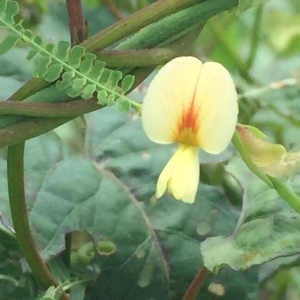Scientific name
Aeschynomene indica L.
Common name
Indian jointvetch
Khmer/Indigenous name
–
Family
Fabaceae
Plant type
Broadleaf
Description/ Characteristics
An erect, branched, 0.3—1.2 m tall, perennial herb or sub-shrub.
Stem: woody, with “wart-like” structures at the base, cylindrical with scattered glandular hairs.
Leaf: alternate, pinnate, 3—8 cm long; leaflets linear or oblong, about 2.5—10 mm long; stipules are lance-shaped and 1—cm long.
Inflorescence: racemes borne in leaf axils with 1—4 flowers: flower yellow and often suffused with purple, up to 10 mm long.
Fruit: a linear-oblong, either straight or curved pod up to 5 cm long and 4 mm wide; seeds black, shiny, and about 3—3.5 mm long.
Habitat
Favors wet situations, in direct-seeded rice and along margins of ditches. Seed has a pronounced dormancy; germination favored by saturated soil conditions.
Control methods
Cultural control: in rice, hand weeding and interrow cultivation in India and Indonesia; in soybean, hand weeding at 20, 35, and 50 days after sowing.
Chemical control: thiobencarb and pendimethalin reported to be effective in direct-sown rice.
http://keyserver.lucidcentral.org/key-server/data/08050103-0a0e-4e01-8a03-040d0c020e0a/media/Html/Aeschynomene_indica.htm
More info: http://www.knowledgebank.irri.org/step-by-step-production/growth/weed-management
Image copyright
Dr Robert J. Martin
University of Sydney
bob.martin@sydney.edu.au


